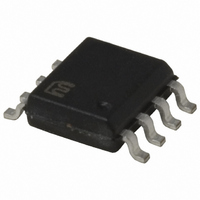MIC5236YM Micrel Inc, MIC5236YM Datasheet - Page 10

MIC5236YM
Manufacturer Part Number
MIC5236YM
Description
IC REG LDO 150MA ADJ VOLT 8SOIC
Manufacturer
Micrel Inc
Datasheet
1.MIC5236YM.pdf
(12 pages)
Specifications of MIC5236YM
Regulator Topology
Positive Adjustable
Voltage - Output
1.24 ~ 20 V
Voltage - Input
2.3 ~ 30 V
Voltage - Dropout (typical)
0.3V @ 150mA
Number Of Regulators
1
Current - Output
150mA
Operating Temperature
-40°C ~ 125°C
Mounting Type
Surface Mount
Package / Case
8-SOIC (3.9mm Width)
Lead Free Status / RoHS Status
Lead free / RoHS Compliant
Current - Limit (min)
-
Other names
576-1285
Available stocks
Company
Part Number
Manufacturer
Quantity
Price
Company:
Part Number:
MIC5236YM
Manufacturer:
MIC
Quantity:
28 191
Company:
Part Number:
MIC5236YM
Manufacturer:
MICREL
Quantity:
1 046
Part Number:
MIC5236YM
Manufacturer:
MICREL/麦瑞
Quantity:
20 000
Company:
Part Number:
MIC5236YMM
Manufacturer:
MICREL
Quantity:
7 383
Part Number:
MIC5236YMM
Manufacturer:
MICREL/麦瑞
Quantity:
20 000
MIC5236
Thermal Characteristics
The MIC5236 is a high input voltage device, intended to
provide 150mA of continuous output current in two very small
profile packages. The power SOIC-8 and power MSOP-8 al-
low the device to dissipate about 50% more power than their
standard equivalents.
Power SOIC-8 Thermal Characteristics
One of the secrets of the MIC5236’s performance is its power
SO-8 package featuring half the thermal resistance of a
standard SO-8 package. Lower thermal resistance means
more output current or higher input voltage for a given pack-
age size.
Lower thermal resistance is achieved by joining the four
ground leads with the die attach paddle to create a single-
piece electrical and thermal conductor. This concept has
been used by MOSFET manufacturers for years, proving
very reliable and cost effective for the user.
Thermal resistance consists of two main elements, θ
tion-to-case thermal resistance) and θ
thermal resistance). See Figure 5. θ
the die to the leads of the package. θ
from the leads to the ambient air and it includes θ
to-sink thermal resistance) and θ
resistance).
Using the power SOIC-8 reduces the θ
allows the user to reduce θ
θ
factor in calculating the maximum power dissipation capabil-
ity of the device. Typically, the power SOIC-8 has a θ
20°C/W, this is significantly lower than the standard SOIC-8
MIC5236
JA
(junction-to-ambient thermal resistance) is the limiting
Figure 4. Remote Enable with Short-Circuit
SHUTDOWN
ENABLE
V
5V
Figure 5. Thermal Resistance
IN
200k
printed circuit board
SOP-8
Current Foldback
q
JC
4.7µF
q
CA
JA
IN
EN
. The total thermal resistance,
q
CA
1N4148
MIC5236
GND
SA
200k
(sink-to-ambient thermal
OUT
ERR
JC
AMBIENT
is the resistance from
CA
CA
JC
heat sink area
ground plane
(case-to-ambient
is the resistance
dramatically and
C
OUT
V
V
ERR
OUT
CS
JC
(case-
(junc-
JC
of
10
which is typically 75°C/W. θ
through 8 can now be soldered directly to a ground plane
which significantly reduces the case-to-sink thermal resistance
and sink to ambient thermal resistance.
Low-dropout linear regulators from Micrel are rated to a
maximum junction temperature of 125°C. It is important not to
exceed this maximum junction temperature during operation
of the device. To prevent this maximum junction temperature
from being exceeded, the appropriate ground plane heat sink
must be used.
Figure 6 shows copper area versus power dissipation with
each trace corresponding to a different temperature rise
above ambient.
From these curves, the minimum area of copper necessary for
the part to operate safely can be determined. The maximum
allowable temperature rise must be calculated to determine
operation along which curve.
For example, the maximum ambient temperature is 50°C,
the ΔT is determined as follows:
Using Figure 6, the minimum amount of required copper can
be determined based on the required power dissipation. Power
dissipation in a linear regulator is calculated as follows:
If we use a 3V output device and a 28V input at moderate
output current of 25mA, then our power dissipation is as
follows:
From Figure 6, the minimum amount of copper required to
operate this application at a ΔT of 75°C is 25mm
Quick Method
Determine the power dissipation requirements for the design
along with the maximum ambient temperature at which the
device will be operated. Refer to Figure 7, which shows safe
operating curves for three different ambient temperatures:
ΔT = T
T
T
ΔT = 125°C – 50°C
ΔT = 75°C
P
P
P
P
A(max)
J(max)
D
D
D
D
Figure 6. Copper Area vs. Power-SOIC
= (V
= (28V – 3V) × 25mA + 28V × 250µA
= 625mW + 7mW
= 632mW
J(max)
= 125°C
= maximum ambient operating temperature
IN
– V
900
800
700
600
500
400
300
200
100
Power Dissipation (∆T
0
0
– T
OUT
0.25 0.50 0.75 1.00 1.25 1.50
A(max)
POWER DISSIPATION (W)
) I
OUT
CA
+ V
is reduced because pins 5
IN
· I
GND
JA
)
Micrel, Inc.
2
July 2005
.












